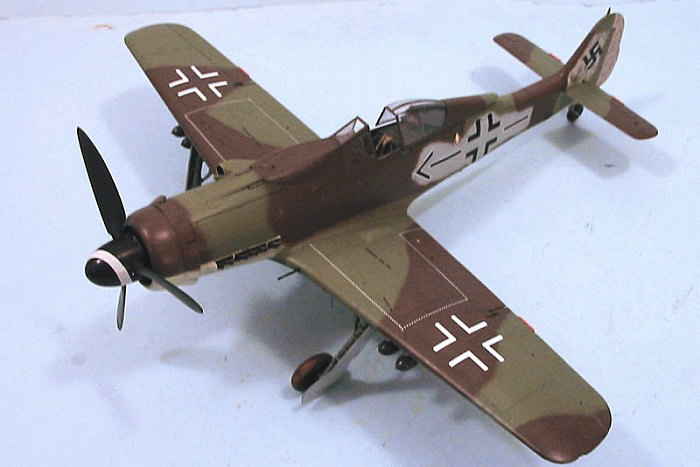
| KIT: | Hasegawa 1/32 FW-190D-9 'Rudel' |
| KIT #: | 08143 |
| PRICE: | $44.95 MSRP |
| DECALS: | One option |
| REVIEWER: | Tom Cleaver |
| NOTES: | Life-Like 32-001 decals used. |

| HISTORY |
Few modelers can fail to be unfamiliar with the Focke-Wulf Fw-190D-9, the most widespread advanced development of the "Wurger," or "Butcher Bird." Seen by its designer Kurt Tank as an "interim" type while he continued to try and obtain official permission to use a Daimler-Benz powerplant, the Fw-190D-9, known also as the "Dora-9" or the "Langnasen Dora," was described by no less an authority than Chuck Yeager as "the best German piston-engine fighter I ever flew," from his days at Wright Field immediately after the war when he participated in the flight testing of captured enemy aircraft.
By
1945, the Dora-9 was in widespread use in the Luftwaffe. The Fw-190D-9/R-5
development was a ground-attack variant that had much the same operational
capability as the Fw-190F-8, being capable of using two wing racks on each wing
for carrying SC50 bombs, and an SC250 bomb on the centerline rack.
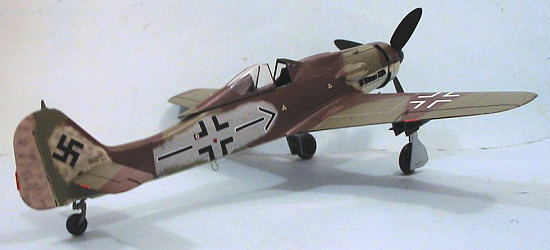 Several D-9s
- some of which may have been the R-5 subvariant - were issued to SG2, which was
at that stage of the war engaged in a rearguard action in Hungary and
Czechoslovakia against advancing Soviet armies; their primary task was provision
of air support to the remaining Ju-87G Stukas and Fw-190Fs of the unit.
Several D-9s
- some of which may have been the R-5 subvariant - were issued to SG2, which was
at that stage of the war engaged in a rearguard action in Hungary and
Czechoslovakia against advancing Soviet armies; their primary task was provision
of air support to the remaining Ju-87G Stukas and Fw-190Fs of the unit.
Hans-Ulrich Rudel:
Legendary Stuka pilot Hans-Ulrich Rudel was the most decorated member of the Luftwaffe, being the only German soldier to receive the Golden Oak Leaves to the Knight's Cross with Diamonds. During his career as a Stuka Pilot on the Eastern Front, Rudel sank the Soviet battleship "Marat," a cruiser, a destroyer, and over 70 landing craft; in land battles, he destroyed over 500 enemy tanks, 800 soft-skinned vehicles, 150 pieces of artillery, and four armored trains, in addition to numerous bridges. He was the foremost exponent of the Kannonenvogel, the Ju-87G development of the Ju-87D, armed with two 37mm cannon underwing. He became Geschwader Kommodore of Schlachtgeschwader 2 in 1943, and continued to use the Stuka after it had disappeared from the inventories of all the other Schlachtgeschwadern as other than a night attack aircraft.
In March 1945, Rudel was badly injured crash landing one of his Stukas, and broke his leg. An indomitable fighter, he finally allowed himself to be talked into flying the Fw-190, due to the fact the control forces were less than with the Stuka, which allowed him to fly his Fw-190D-9 while still in a full leg cast. During these final weeks of the war, Rudel added to his wartime record by shooting down 9 Soviet fighters.
| THE KIT |
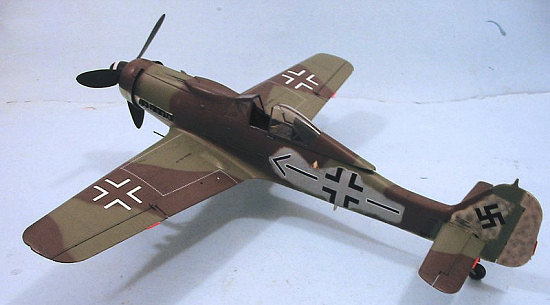 There have been other 1/32 kits of the Focke-Wulf Fw-190D-9 that were released
in the 1970s. For all intents and purposes, those kits are now large "door
stops," with the release of this all-new 1/32 Dora by Hasegawa. The kit is
crisply-molded, and engineered in such a way that it is obvious they will
continue the Hasegawa policy of milking out every sub-type of an airplane that
can be done with minimal changes to the parts selection. Most importantly, this
is the first Dora kit that has the open wheel well and provision of the rear
section of the Jumo powerplant.
There have been other 1/32 kits of the Focke-Wulf Fw-190D-9 that were released
in the 1970s. For all intents and purposes, those kits are now large "door
stops," with the release of this all-new 1/32 Dora by Hasegawa. The kit is
crisply-molded, and engineered in such a way that it is obvious they will
continue the Hasegawa policy of milking out every sub-type of an airplane that
can be done with minimal changes to the parts selection. Most importantly, this
is the first Dora kit that has the open wheel well and provision of the rear
section of the Jumo powerplant.
This particular limited release includes the under wing bomb racks and four SC 50 bombs, though it does not include a larger bomb. The one and only known photograph of this airplane shows it carrying a late war drop tank. Decals are included for this airplane only.
| CONSTRUCTION |
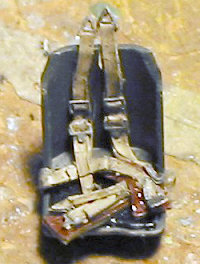 I’ve said it before and will say it again: this kit is so well-designed, and
goes together so easily, that a modeler really has to go out of their way to
mess up the assembly.
I’ve said it before and will say it again: this kit is so well-designed, and
goes together so easily, that a modeler really has to go out of their way to
mess up the assembly.
Modelers can get any one of the "super kit" resin upgrades for this that have been produced by aftermarket companies the way Hermann Goering told Kurt Tank to produce the Fw-190 ("like hot rolls"), but - for me at least - the problem is that when it's assembled, there is not that much there to be seen in an Fw-190 cockpit. For this kit, I used the kit cockpit, supplementing it with a Cutting Edge 1/32 posable resin seatbelt set, which is really about all one really needs.
Once the cockpit was painted and assembled, I painted all the engine parts per instructions, then put together that sub-assembly.
After gluing the cockpit tub, engine bay and exhaust stubs into position, I
glued the fuselage together. I had previously glued each tail half to its
respective fuselage half at the outset. There was almost no centerline seam. Do
remember: the rear fuselage does have a centerline seam on the upper
surface (like the Bf-109), and it is correctly offset to the right in the
fuselage extension. You'll only need a bit of Mr. Surfacer 1000 for the seam on
the upper engine cowl, since the lower centerline seam is correct for the panels
that are opened to service the engine. I attached the
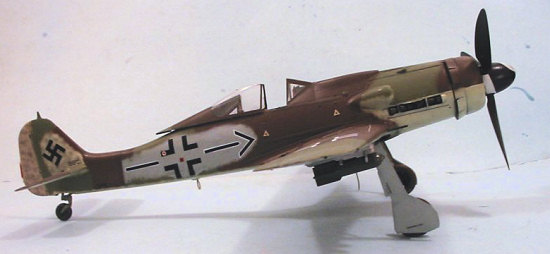 horizontal stabilizers and
finished the sub assembly by attaching the radiator and cowling. I decided to
do this Dora with the flaps up.
horizontal stabilizers and
finished the sub assembly by attaching the radiator and cowling. I decided to
do this Dora with the flaps up.
Having already pre-painted the wheel wells when I pre-painted the other interior parts, assembly of the wing was a breeze. The wheel well is attached to a wing spar that absolutely guarantees the wing will have the correct dihedral. This is as important a point as the engineering of the gear legs, since incorrect dihedral and improperly-aligned landing gear are the to major places where modelers "screw the pooch" when they build Fw-190 models previous to this one.
Attachment of the wing to the fuselage is a bit "fiddly. However, test-fitting a couple times to see what was what insured that when I did apply glue, I knew how to make the parts "snap together." The rear wing root joint on both wings seemed to want to pop loose. I fixed this by applying some cyanoacrylate to the area through the flap well, and held the joint in position until the glue hardened.
It was time to head to the paint shop.
| COLORS & MARKINGS |
Painting:
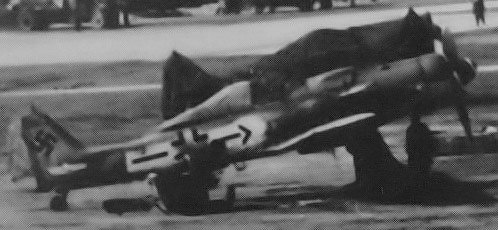 With only the one not so clear photograph of this airplane, Rudel’s Dora is
“open to interpretation.” The guys at Lifelike Decals recommend RLM 75 and RLM
82 upper surfaces, with RLM 76 lower surfaces. This is as good a guess as any,
but to me it results in a pretty “white bread” model. Given the variety of
colors late war Luftwaffe aircraft could carry - none of which can be confirmed
with available black and white photos - a modeler can get almost as wild and
crazy as they want to be, and no one from the Kolourpolizei can prove
them wrong.
With only the one not so clear photograph of this airplane, Rudel’s Dora is
“open to interpretation.” The guys at Lifelike Decals recommend RLM 75 and RLM
82 upper surfaces, with RLM 76 lower surfaces. This is as good a guess as any,
but to me it results in a pretty “white bread” model. Given the variety of
colors late war Luftwaffe aircraft could carry - none of which can be confirmed
with available black and white photos - a modeler can get almost as wild and
crazy as they want to be, and no one from the Kolourpolizei can prove
them wrong.
After applying “preshading: over all the panel lines by airbrushing flat black, it was time to camouflage this bird.
I
opted for a scheme that - to me - seems reasonable for a Fw-190D-9/R5 used in
the ground attack role. I left the center area of the lower wing in unpainted
metal, while the ailerons were painted the unofficial “RLM 84" Tan, which I
believe exists from the part of a Fw-190 Jerry Crandall once showed me. I used
Xtracrylix “Gulf War Armor Tan” for this color, and applied it to the ailerons,
elevators and rudder. Assuming that the gear doors were done by a
subcontractor, I painted them RLM 76. The flaps were painted overall RLM 02.
The overall underside camouflage color was the “RLM 84" Sky, which I did with
Gunze-Sangyo “Sky,” 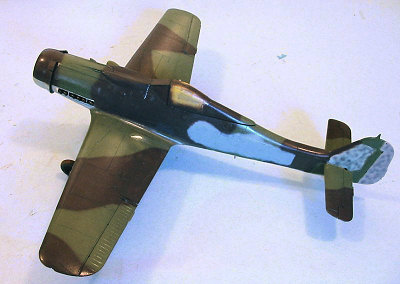 since it closely approximates the piece of airplane with
this color on it Jerry Crandall showed me. The upper surfaces were done with Xtracrylix RLM 81 “Braunviolett” and RLM 83 “Light Green”. Studying the photo,
it seems to me that these colors were carried down the sides of the fuselage, in
what might have been a field-applied camouflage. The rear fuselage is
prominently oversprayed with what is undoubtedly RLM 76 “Light Blue” so that the
old Luftwaffe markings for Geschwader Kommodore can be clearly seen. This was
undoubtedly an aid to identification for Rudel. I used Xtracrylix RLM 76 for
this. The prop spinner was painted black and the blades are RLM 70 “Schwartzgrun”.
Again, this is all Xtracrylix.
since it closely approximates the piece of airplane with
this color on it Jerry Crandall showed me. The upper surfaces were done with Xtracrylix RLM 81 “Braunviolett” and RLM 83 “Light Green”. Studying the photo,
it seems to me that these colors were carried down the sides of the fuselage, in
what might have been a field-applied camouflage. The rear fuselage is
prominently oversprayed with what is undoubtedly RLM 76 “Light Blue” so that the
old Luftwaffe markings for Geschwader Kommodore can be clearly seen. This was
undoubtedly an aid to identification for Rudel. I used Xtracrylix RLM 76 for
this. The prop spinner was painted black and the blades are RLM 70 “Schwartzgrun”.
Again, this is all Xtracrylix.
Once this was dry, I gave the model a coat of Future.
Decals:
This new sheet is Lifelike Decals’ first venture into 1/32, and it’s very nice. In addition to the markings for Rudel’s Dora-9, it has markings for Addi Glunz’s Fw-190A-7, “Weiss 9” and two other Fw-190s that haven’t been “done to death.” Lifelike is, I believe, the first decal company to do markings for Glunz’s favorite Fw-190, and I intend to make use of them with the 1/48 sheet. These decals are really good - very thin, and they go down easily with Micro-Sol. Full stenciling and detail markings are provided.
When the decals were dry, I washed the model to get rid of solvent residue and gave it three coats of Xtracrylix Flat Varnish.
| FINAL CONSTRUCTION |
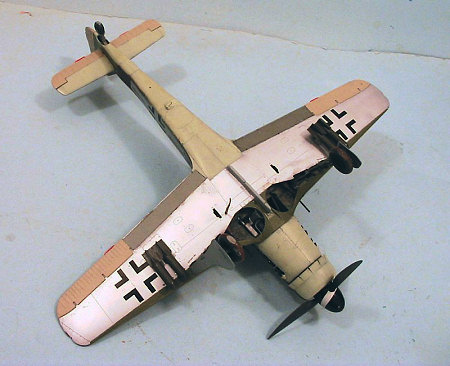 Since I had already attached the landing gear prior to external painting, I had
only to attach the prop, unmask the canopy and attach it in the open position,
then attach the bombs.
Since I had already attached the landing gear prior to external painting, I had
only to attach the prop, unmask the canopy and attach it in the open position,
then attach the bombs.
I didn’t weather the model heavily because you don’t see a lot of grunge on the real airplane in that one photo. Rudel didn’t have enough time to fly it frequently enough to ding it up.
| CONCLUSIONS |
I enjoy doing late war Luftwaffe airplanes because you can be very creative with the colors you use, and no one can prove you wrong. This Wurger looks completely different from all the others in my collection, and I like that fact a lot. This limited-release kit was put out in 2004 at the latest (it might even have been 2003), and is long out of production. They show up occasionally on shop shelves, dredged up from the supply warehouse, which is how I found this one. The kit decals are nice, but the Lifelike sheet is superior. Either way, you can end up with a very different-looking Dora.
Kit courtesy of my wallet. Decals courtesy of Lifelike Decals.
April 2007
If you would like your product reviewed fairly and quickly by a site that has nearly 350,000 visitors a month, please contact me or see other details in the Note to Contributors.